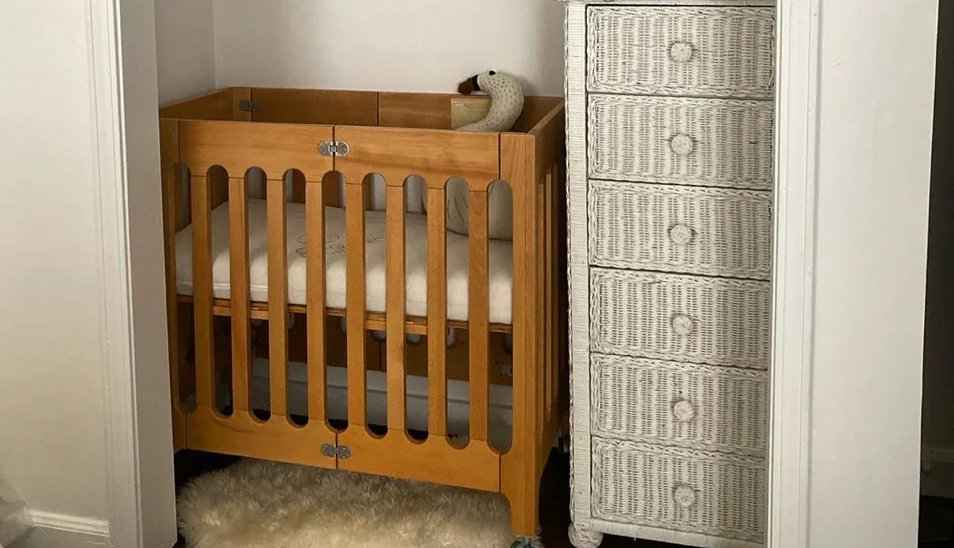
Why Less Space Doesn’t Mean Less Comfort
When we were setting up a nursery corner in our one-bedroom apartment, I had one recurring thought: “Where on earth will the crib go?” I’d seen dreamy Pinterest nurseries with floor-to-ceiling bookshelves, rocking chairs, and space to spare—but that just wasn’t our reality. And I know we’re not alone in this.
Small-space parenting isn’t some trendy minimalism—sometimes, it’s just how things are. Whether you’re in a city apartment, sharing a room with your baby, or setting up a corner in grandma’s house, you can absolutely create a cozy, functional sleep spot. And no, you don’t have to give up quality or safety along the way.
You don’t need a big nursery to give your baby big comfort. It’s all about smart, intentional choices.
What to Look for in a Crib When Space Is Tight
Once you accept that you won’t have a full-sized nursery, crib priorities start to shift. Suddenly, measurements matter more than color palettes. Here’s what really counts when every inch matters:
- Size and shape: Look for mini cribs, portable models, or bassinets with a small footprint.
- Mobility: Wheels can be a game-changer when the crib needs to move in and out of place.
- Storage: Some models have built-in drawers underneath—huge bonus when drawer space is limited.
- Assembly: In small rooms, cribs that are easy to disassemble or fold can offer major flexibility.
When we were shopping, I walked around the apartment with a measuring tape and masking tape, mapping out how much space we could realistically use. It looked ridiculous—but it worked. Turns out, a few centimeters here or there can make or break how comfortably you live in your space day to day.
Measure twice, nap once. A crib that technically fits might still be too bulky for your actual life.
Smart Crib Options That Save Space
Let’s break down a few crib styles that have saved my sanity—and my square footage:
Mini Cribs: These are smaller than standard cribs but still roomy enough for safe sleep up to 18–24 months. Many fold flat or convert to toddler beds. We used one with my son until he turned two, and honestly, we never felt like we were missing anything.
Bassinet-crib combos: Great for the early months, especially if your baby sleeps in your room. Some models even have built-in storage or height adjustability, which can be helpful if you’re recovering from a C-section or just tired (so… always).
Cribs with wheels: If your crib needs to share space with a home office or dining area, having one you can quietly roll away during the day is invaluable. I’ve worked with families who tuck the crib away behind a curtain or shelving unit when it’s not in use.
Foldable travel cribs: These are surprisingly comfortable and sturdy now. Some families use them full-time in tight spaces or during transitions. We brought one to my mom’s place, and it ended up being our backup crib for a full year.
Sometimes the best crib isn’t the biggest—it’s the one that makes your home work better.
What Worked for Us: Real Life in a Small Apartment
In our first place, the baby slept in what used to be my reading corner. We went with a mini crib on wheels, wedged between a dresser and the bed. At night, I could reach him without even getting up. During the day, I rolled it to the window to get some natural light for his naps.
Later, when we moved to a slightly bigger place (read: one more wall), we upgraded to a full-size crib with storage underneath. That crib held not just the baby, but diapers, linens, and the rotating stash of swaddles and pajamas that seemed to multiply overnight.
Every step of the way, the crib we picked had to serve more than one purpose. Sleep, of course—but also space-saving, peace of mind, and fitting in with the rest of our very lived-in home.
Parenting in small spaces forces you to ask: what do we actually need? The answer is usually: not much—but it better work well.
Biggest Truth: Size Doesn’t Equal Quality
At the end of the day, a baby crib isn’t about square footage. It’s about safety, comfort, and how well it fits into your actual routine. If your baby is sleeping well, you feel calm putting them down, and the crib isn’t adding stress to your day—then it’s the right crib, no matter the dimensions.
Don’t let big marketing photos fool you. Your baby doesn’t need a castle—they need a safe, warm, consistent sleep spot. And you need a home that still feels like yours, not like it’s been overrun by furniture you don’t really need.
Your home is allowed to be small. Your parenting still gets to feel spacious.


